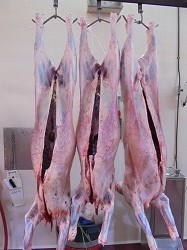 |
MINTRAC | |||
| National Meat Industry Training Advisory Council Limited |
Grass seed contamination assessment modelAs part of an MLA funded project MINTRAC has worked with the Victorian DPI and an industry steering group to develop a standardized measure of grass seed contamination that can be used by QA personnel or meat inspectors to describe the extent of grass seed contamination in a lot. When utilizing the model, grass seed is not recorded unless the lot has to be dealt with differently by: If one or more of the above measures have to be employed to deal with the grass seed contamination then the carcases will be graded as having heavy, medium, light grass seed contamination. A carcase is scored as “heavy grass seed” if there are any grass seeds in the loin or back leg. This reflects the issues that even a small number of grass seeds in this region can have for high value cuts. If there are grass seeds in the forequarter then the carcase is graded as having “medium grass seed” contamination. However, if the grass seed is confined to the belly area the grass seed is said to be “light”. It is important to remember that no carcases are scored unless they have to be processed in some way differently. If there are no grass seeds then the carcase is graded as nil grass seed contamination. At the end of the lot the QA officer or inspector estimates the % in each of the four categories eg 40% heavy, 20% medium and 20% light.
|
